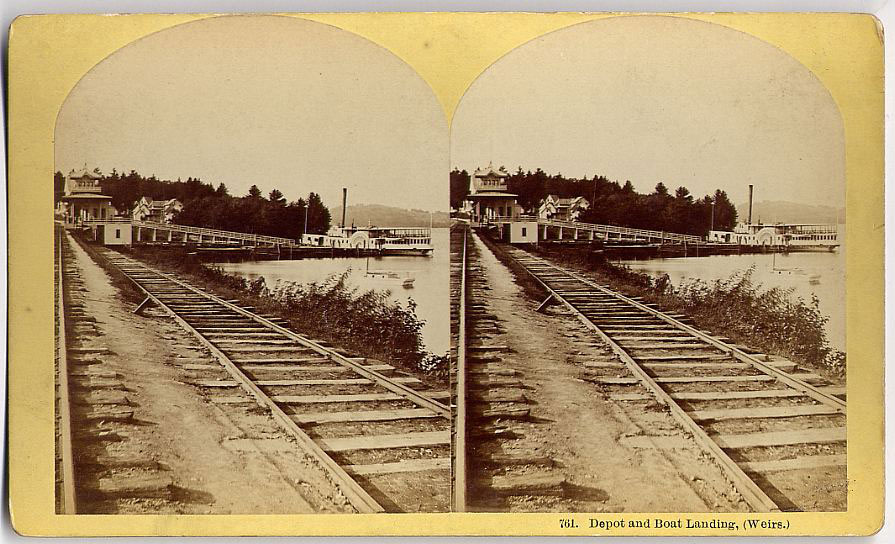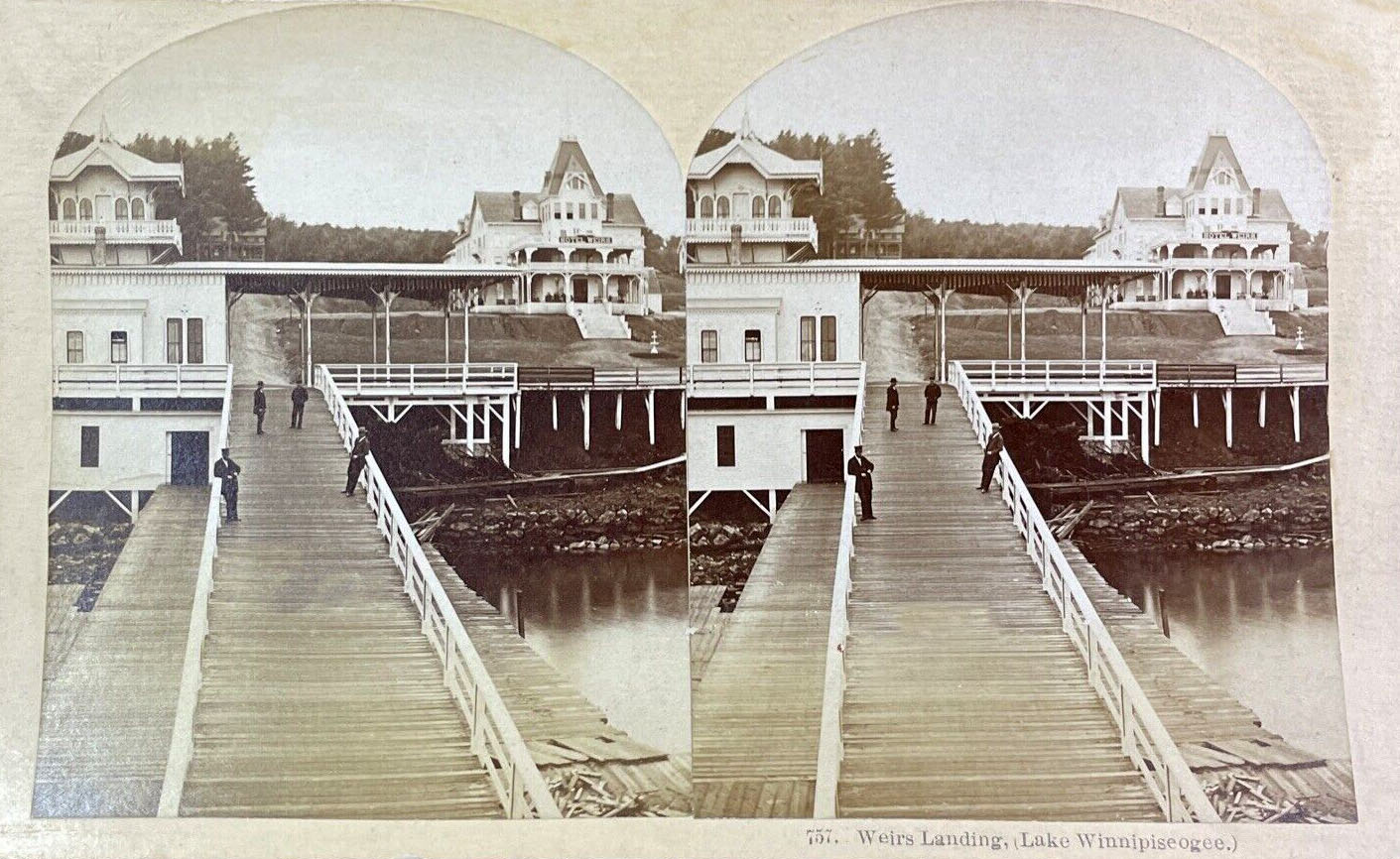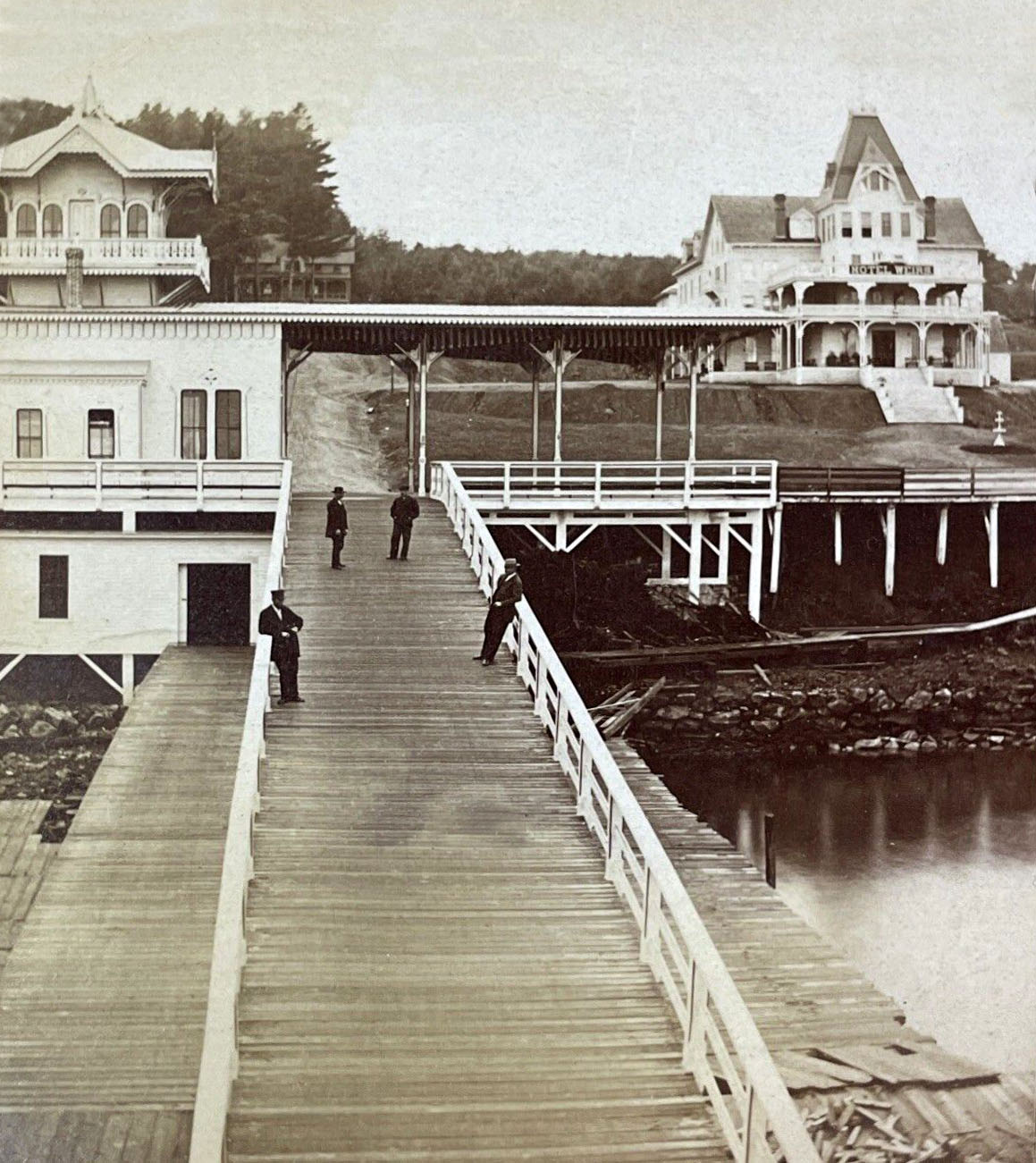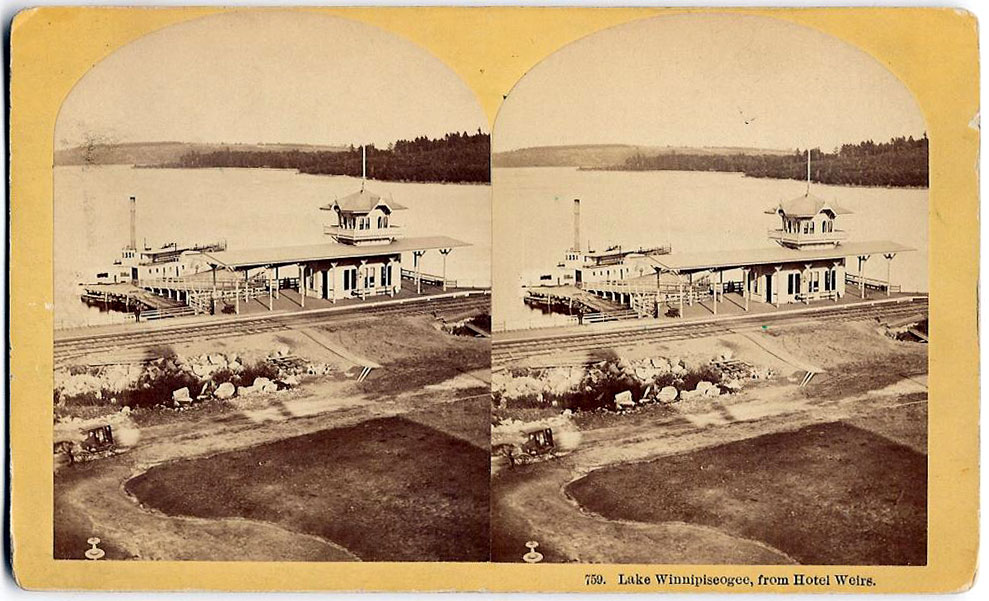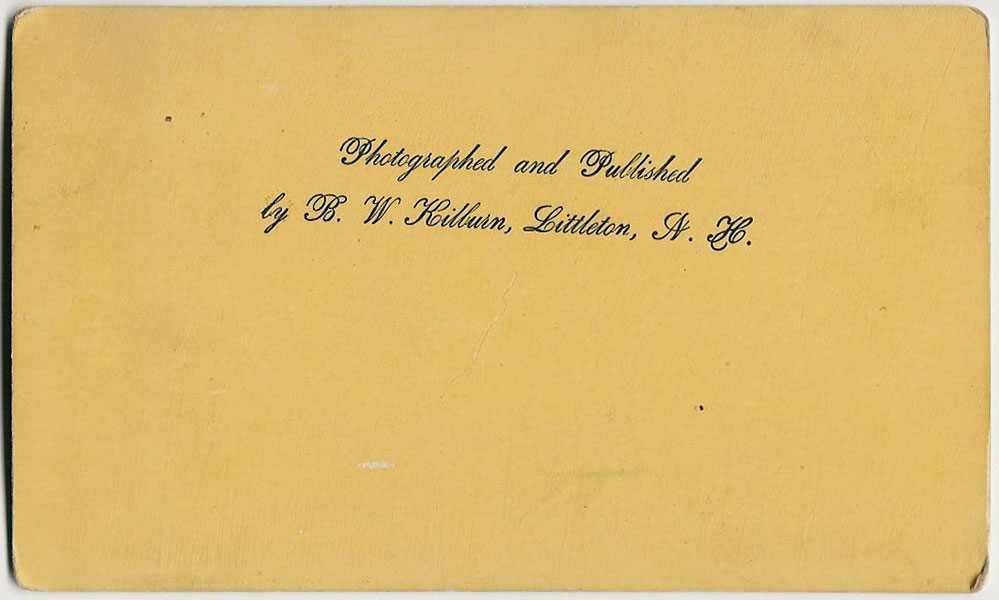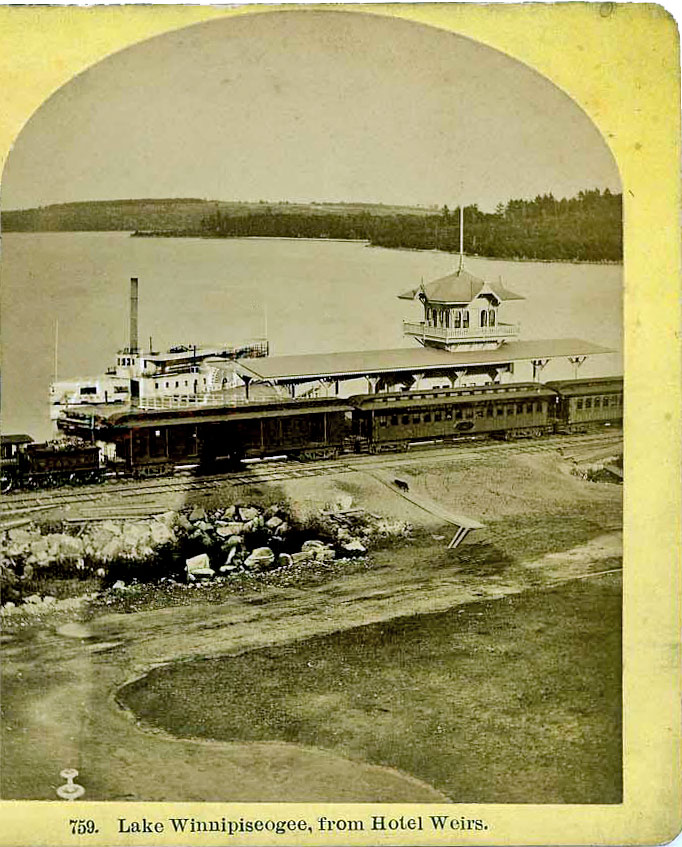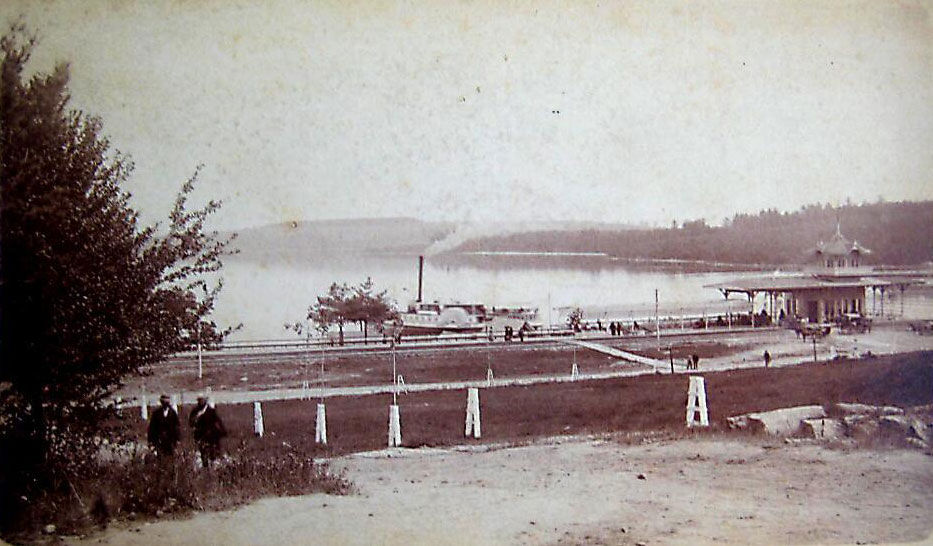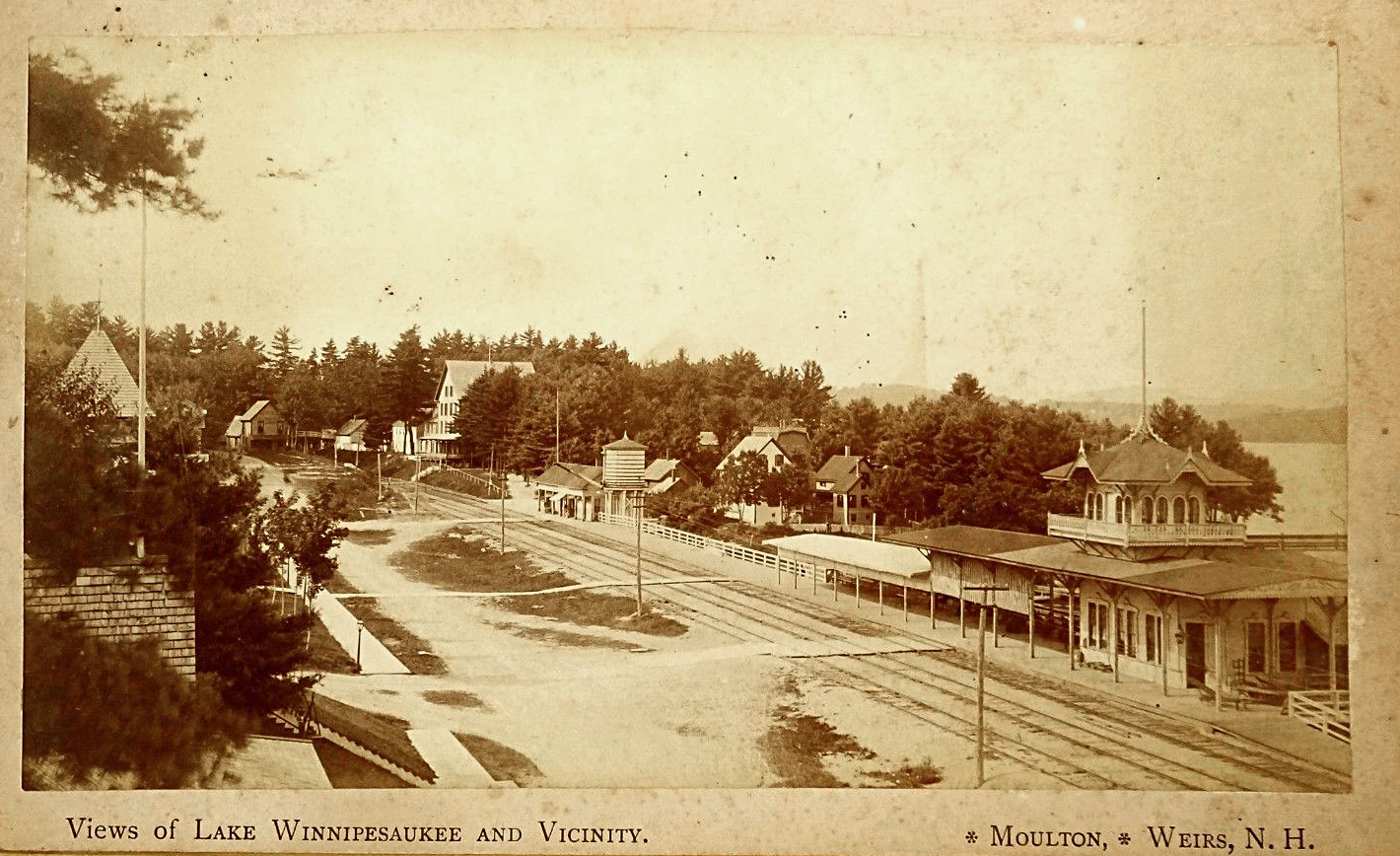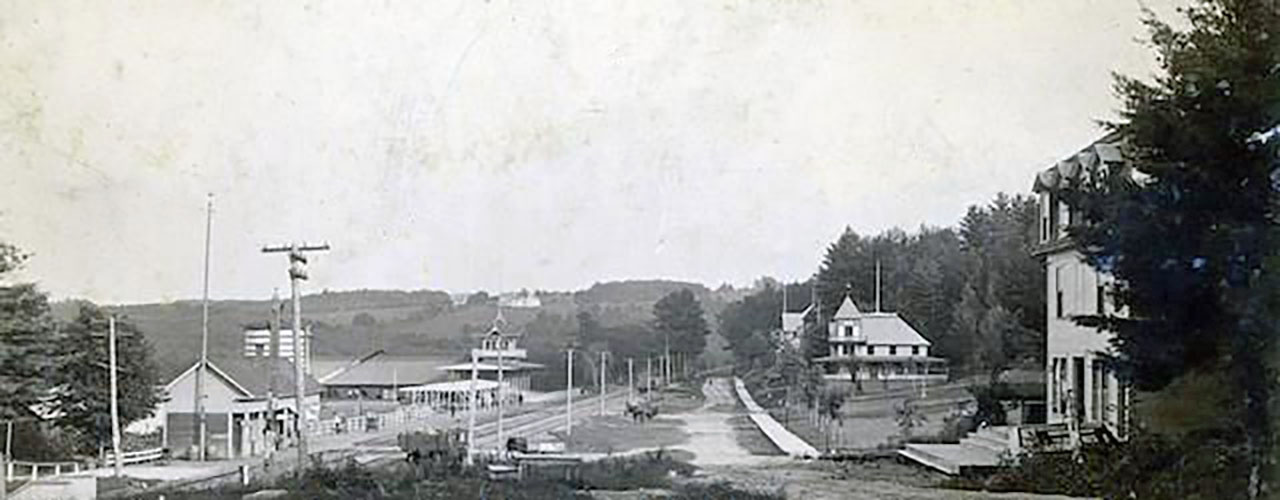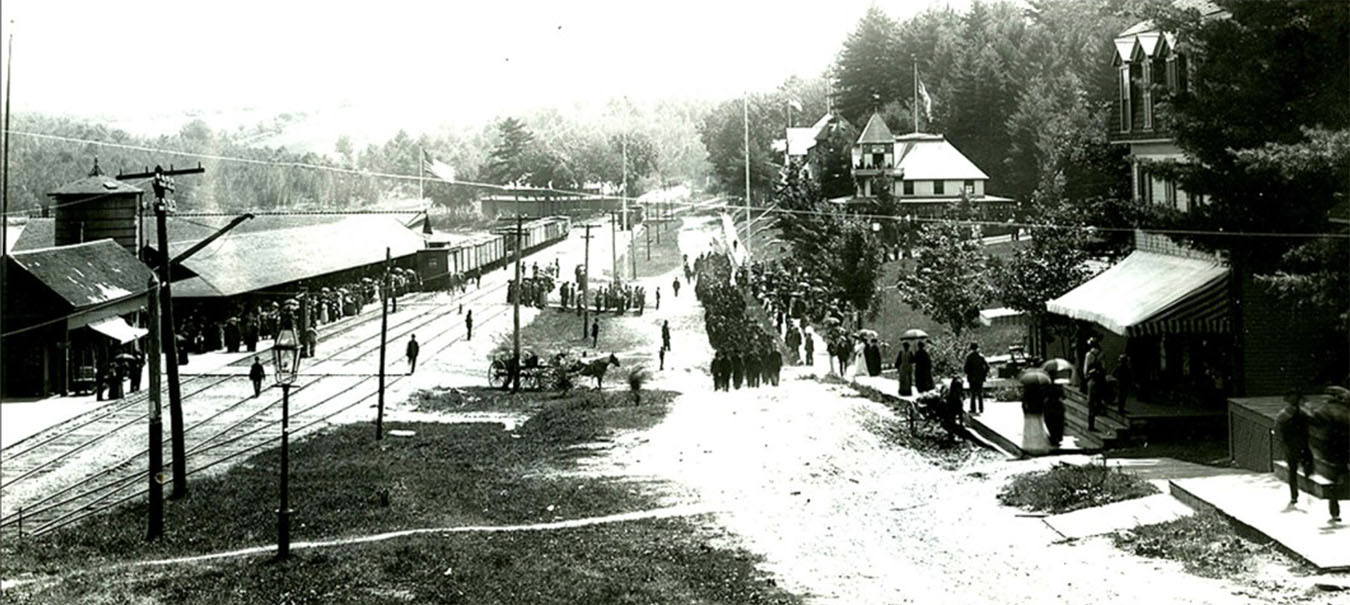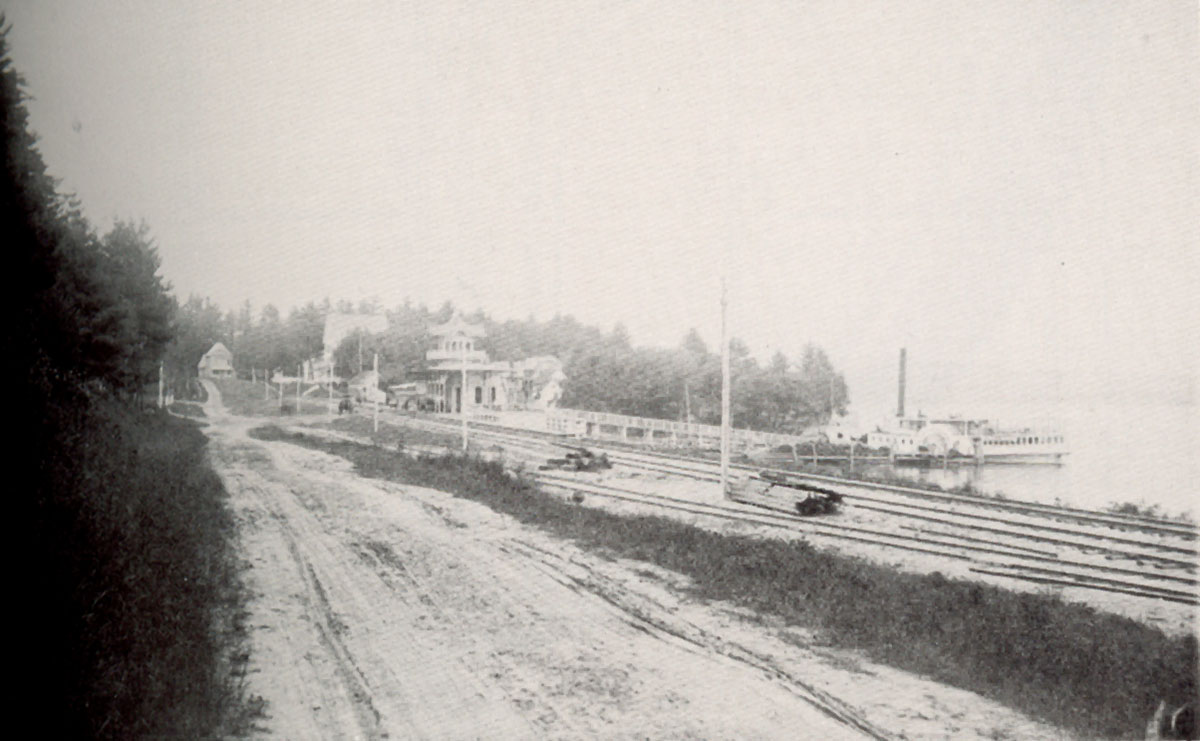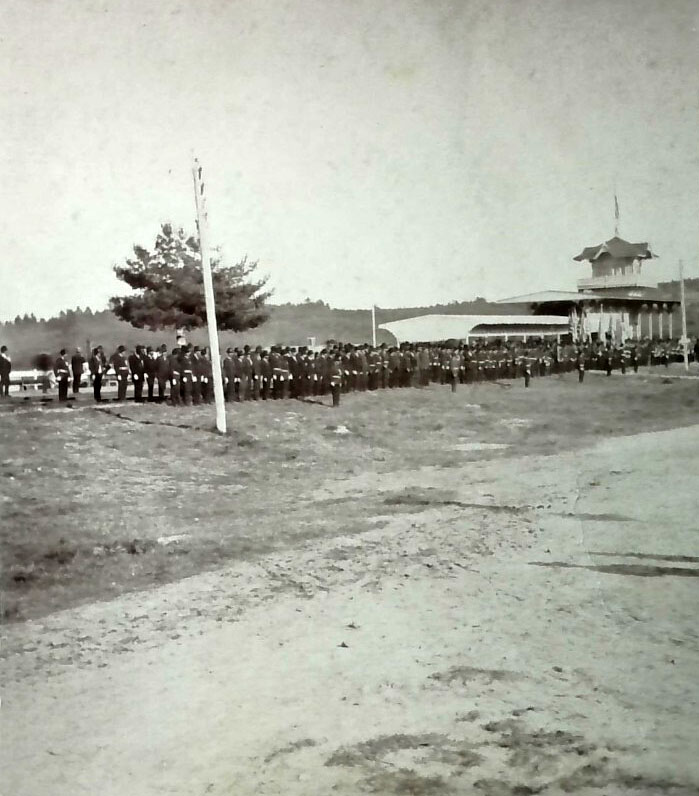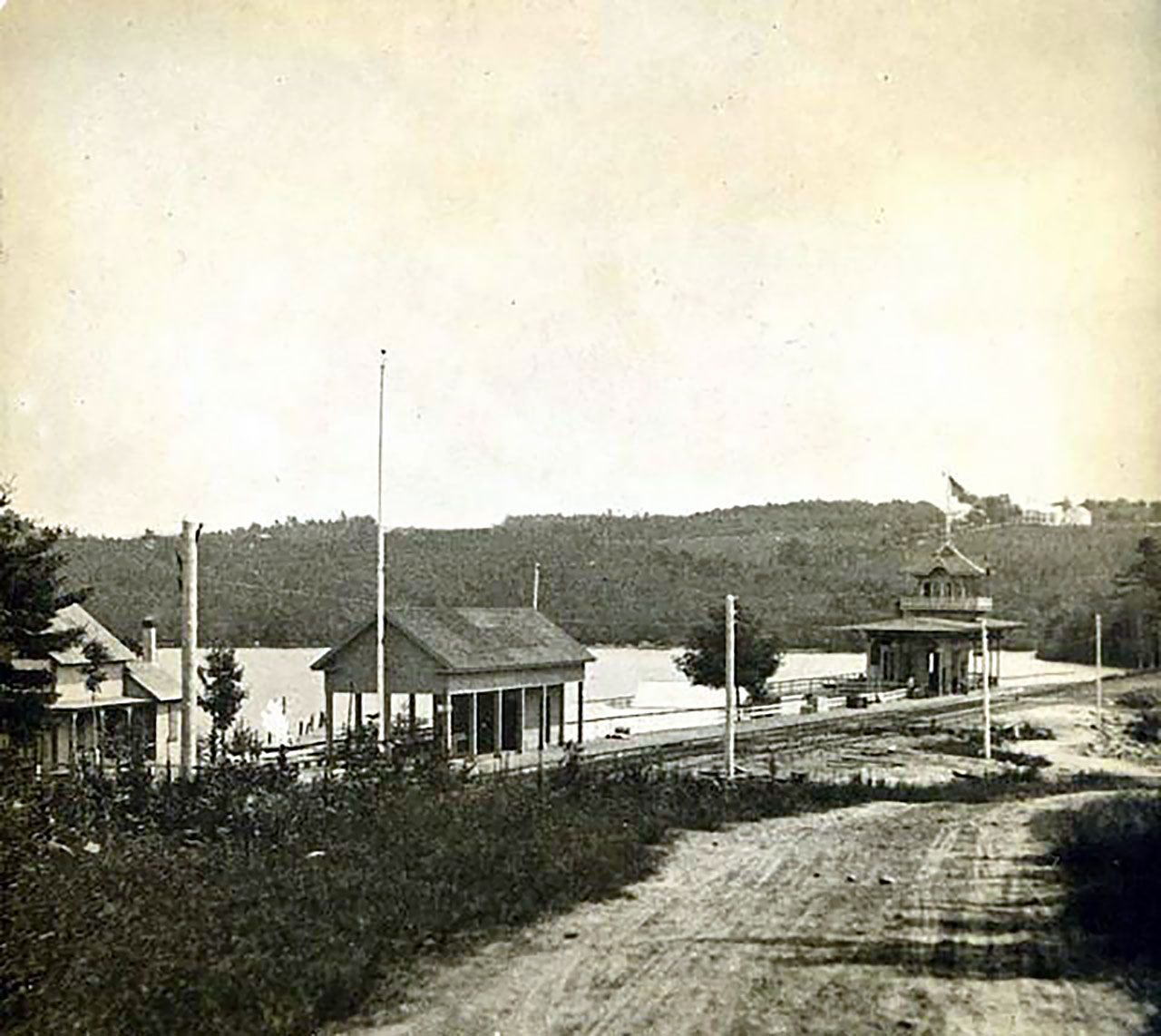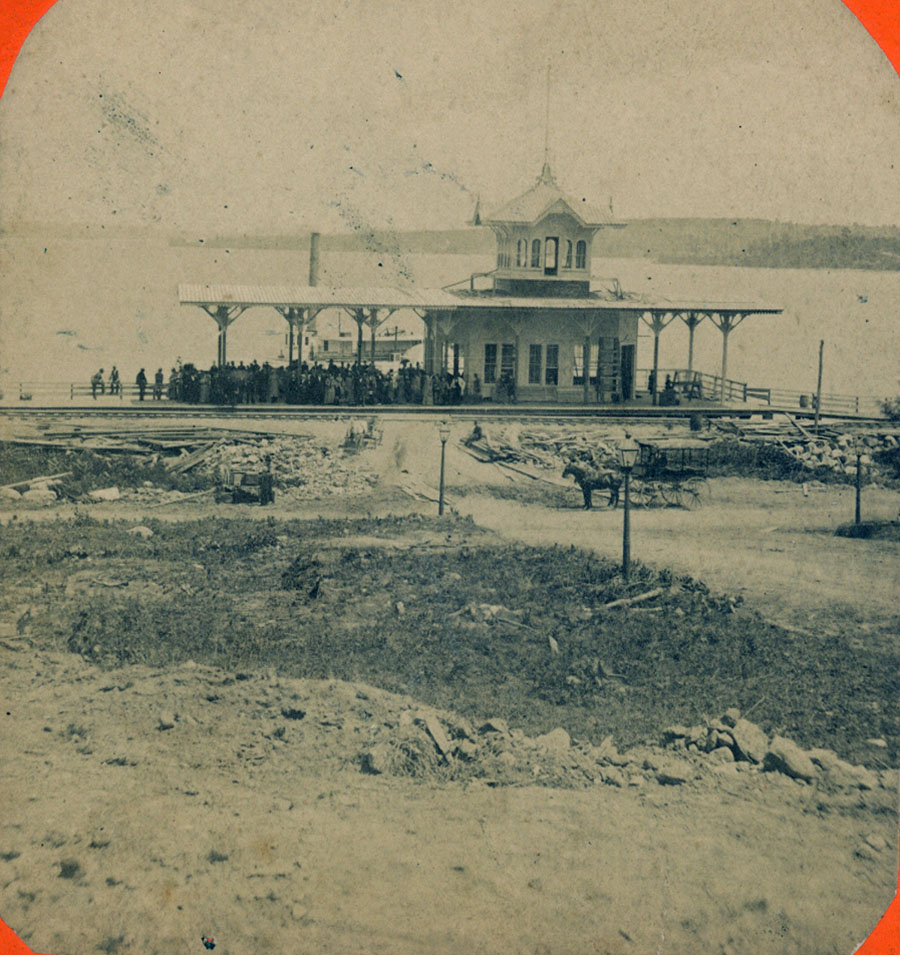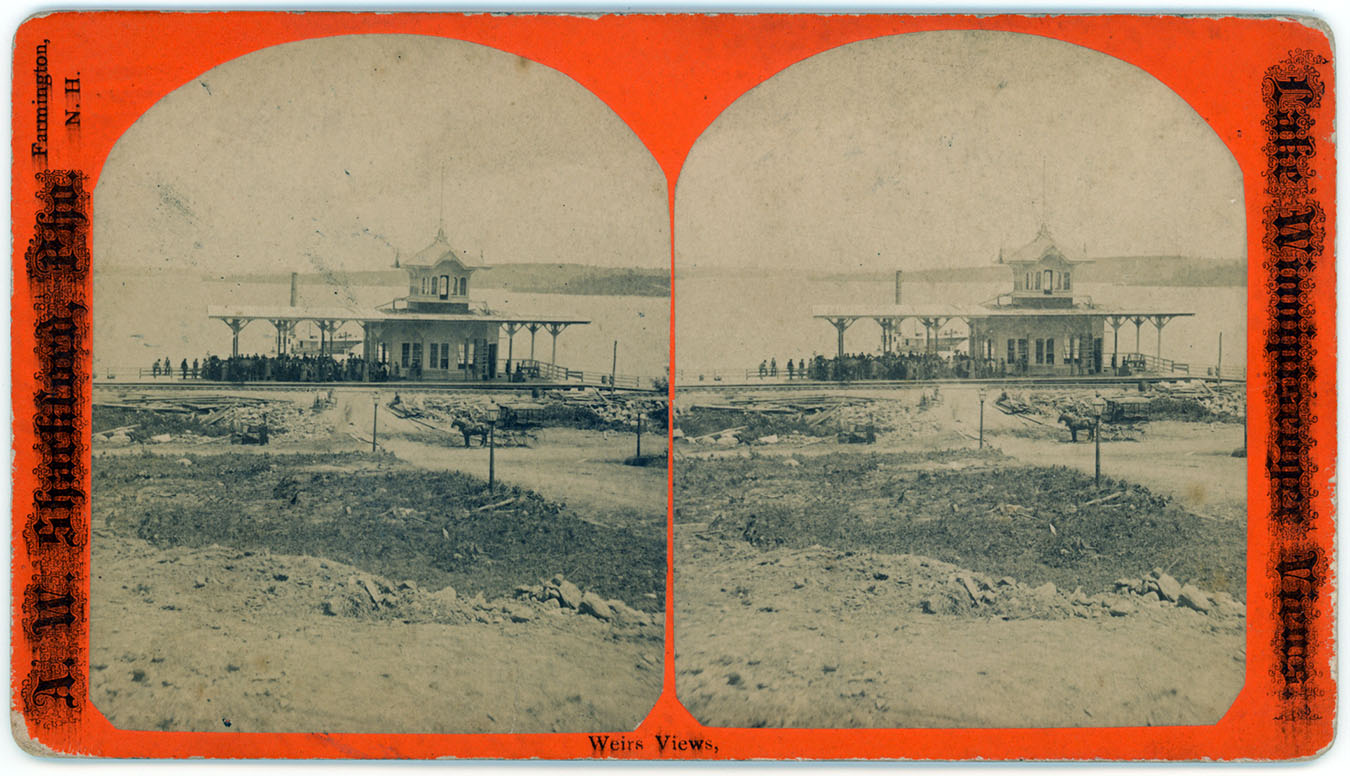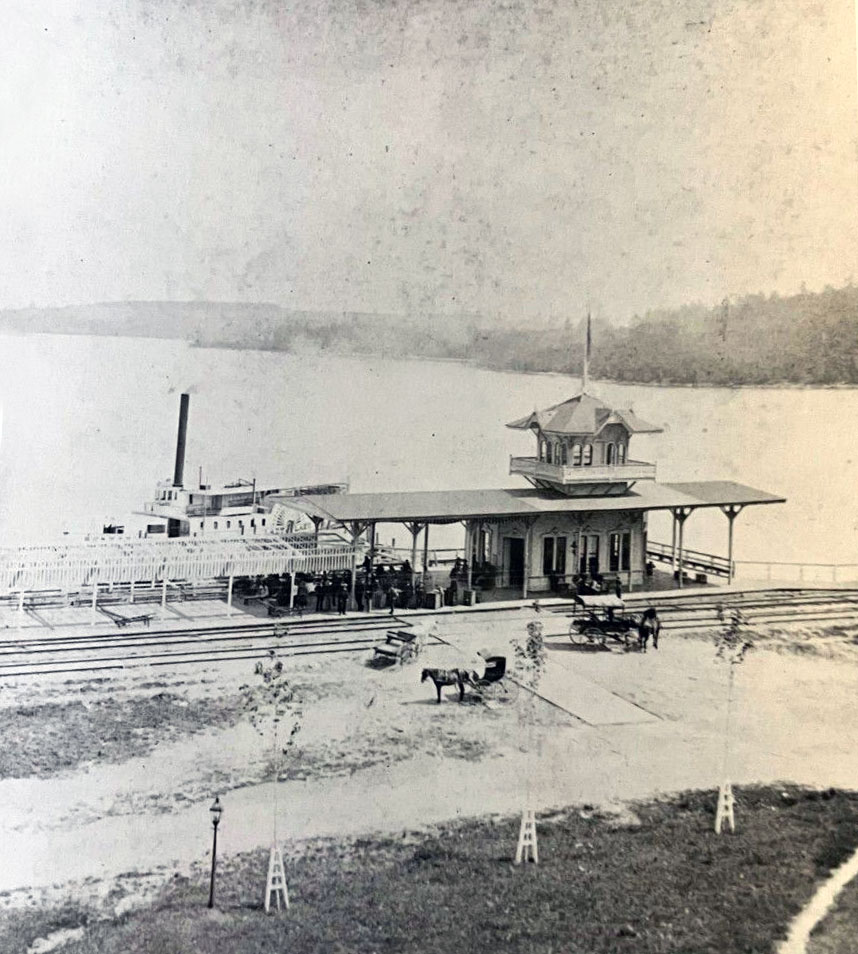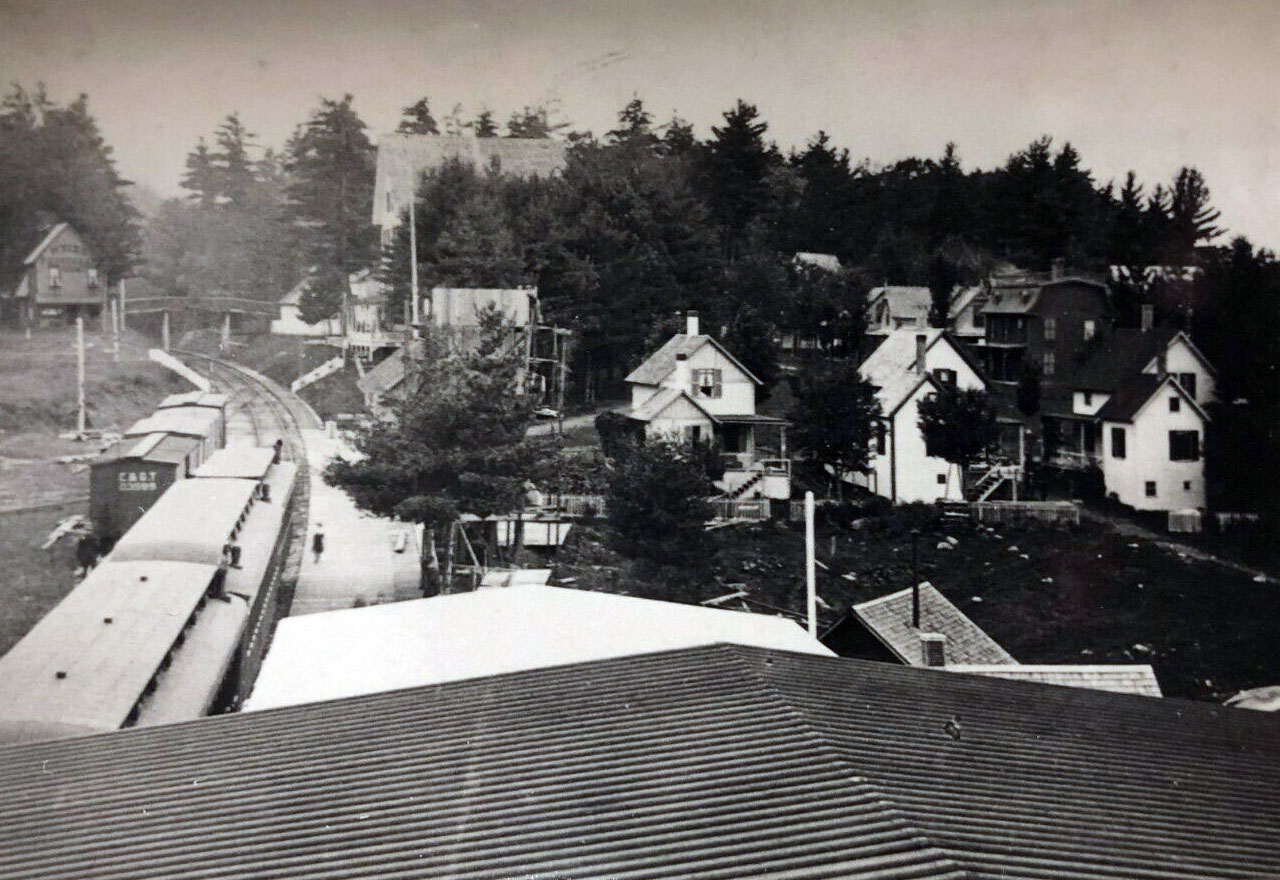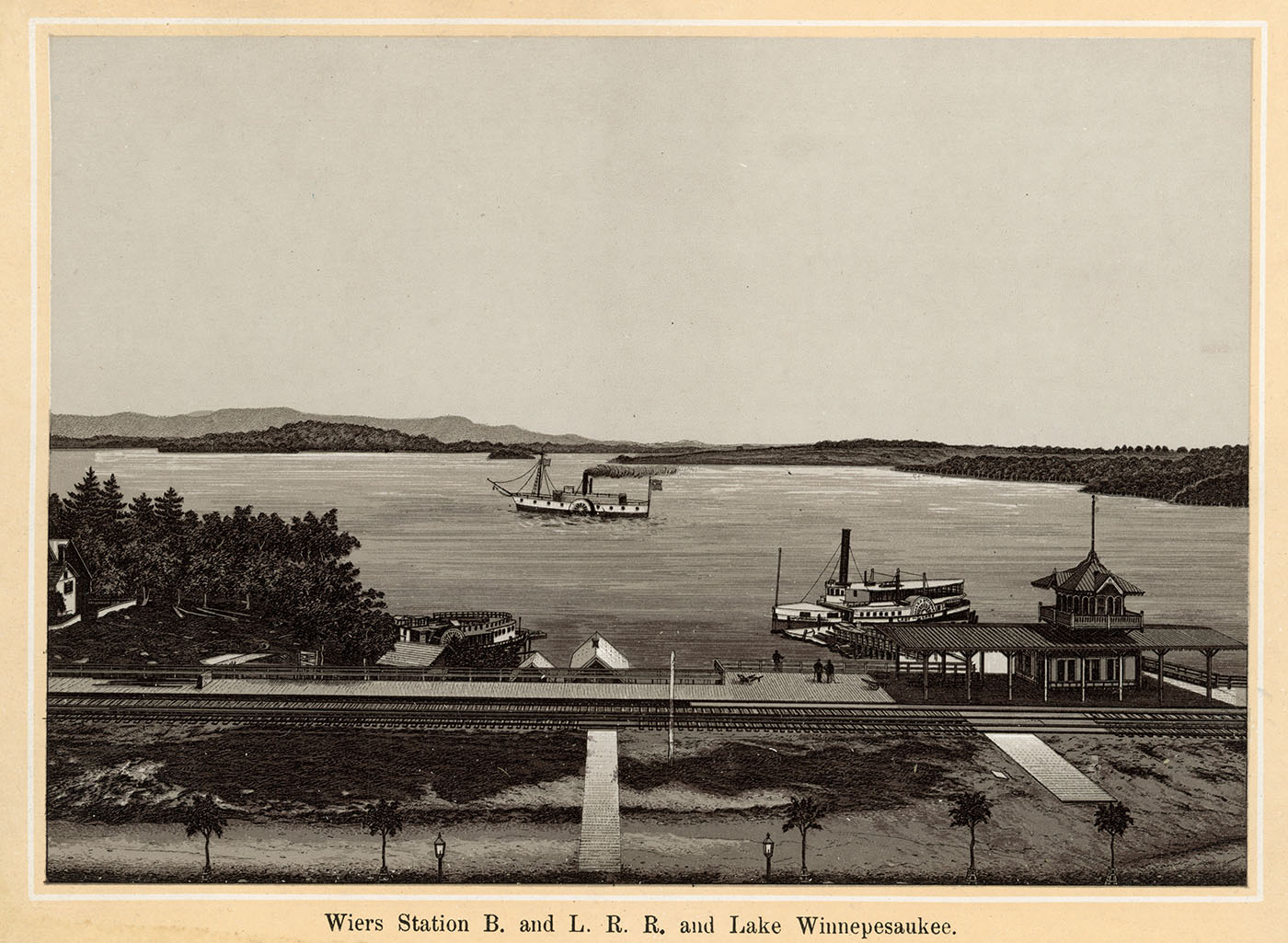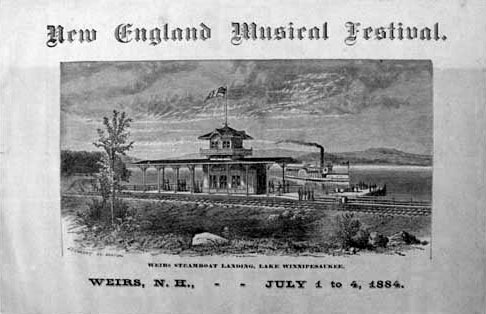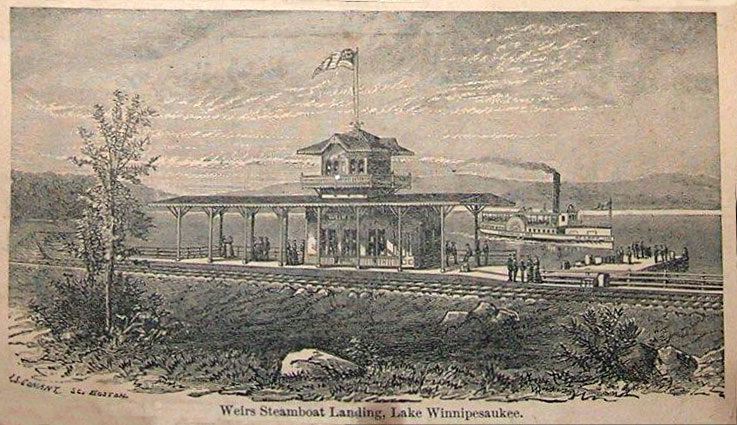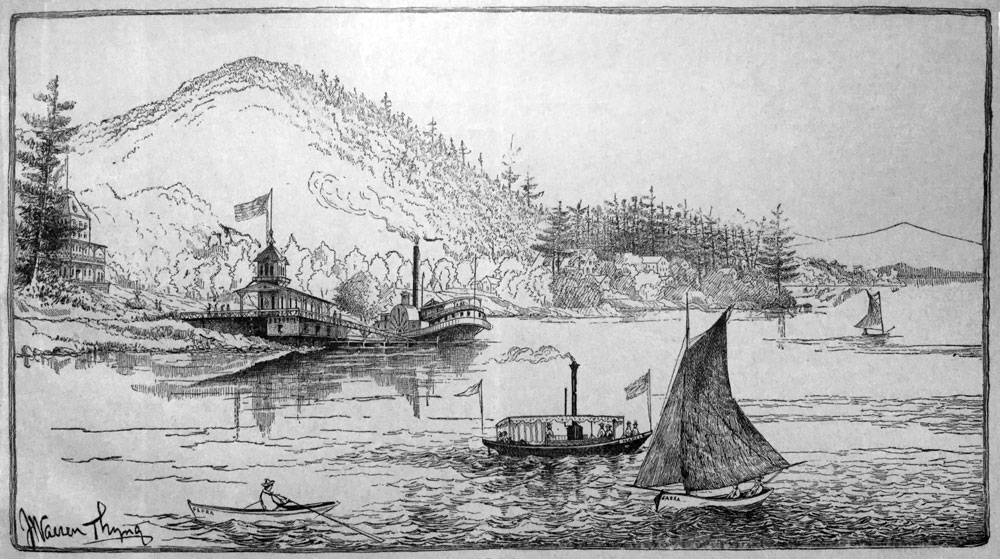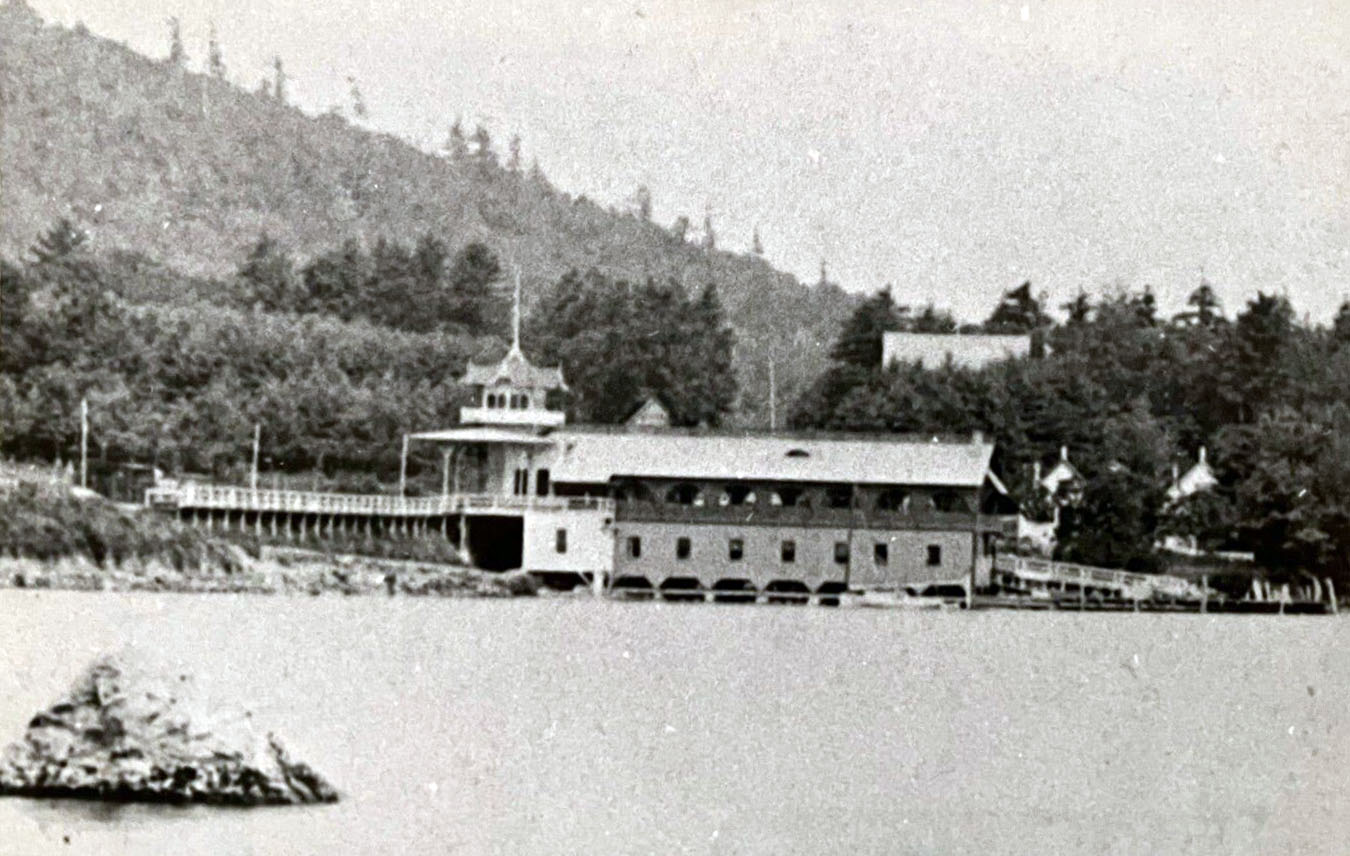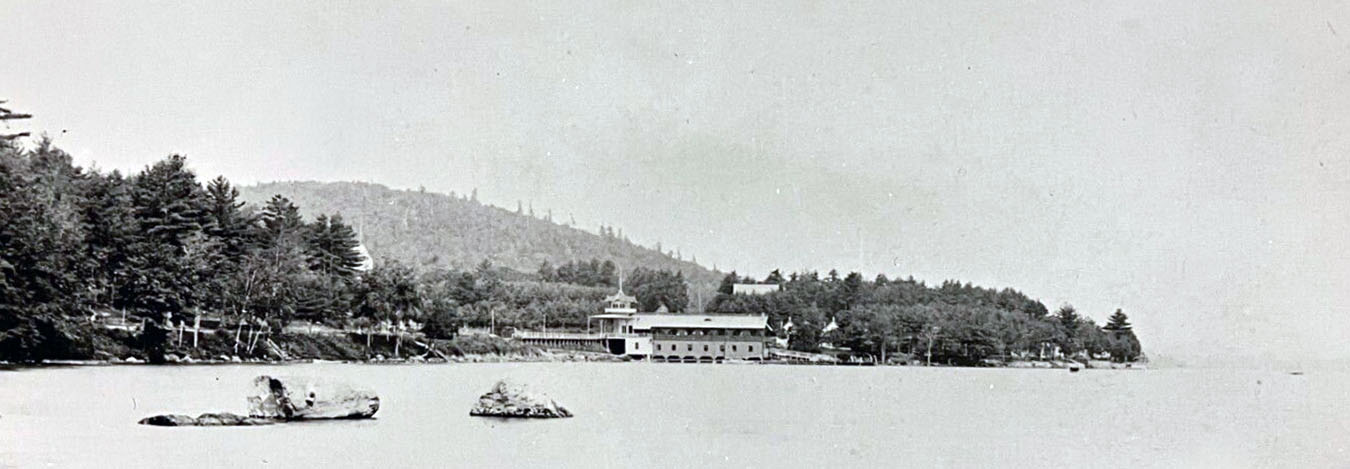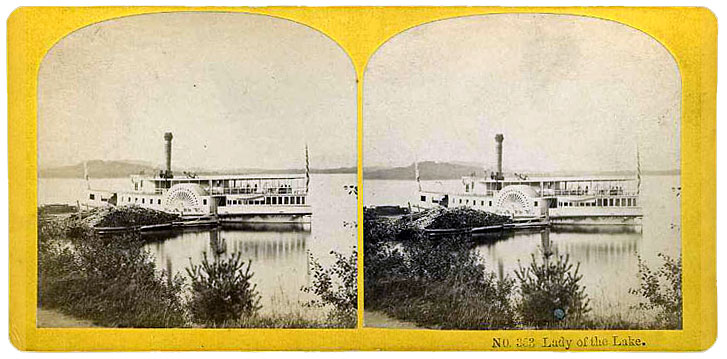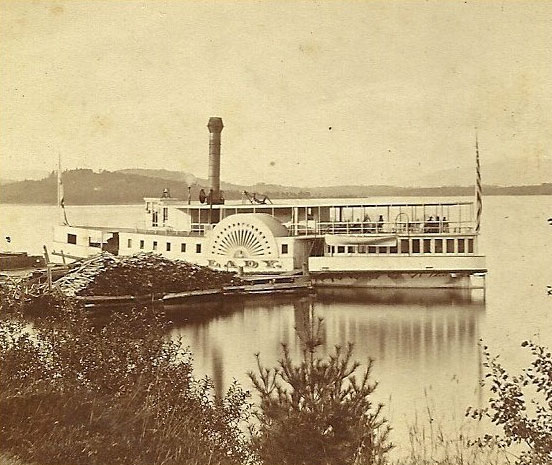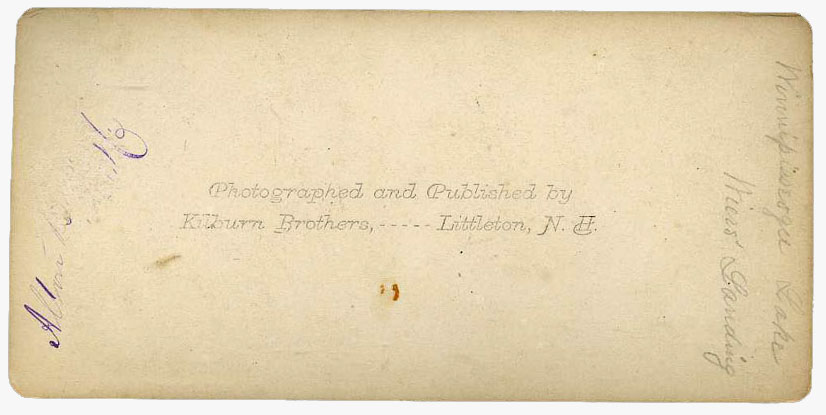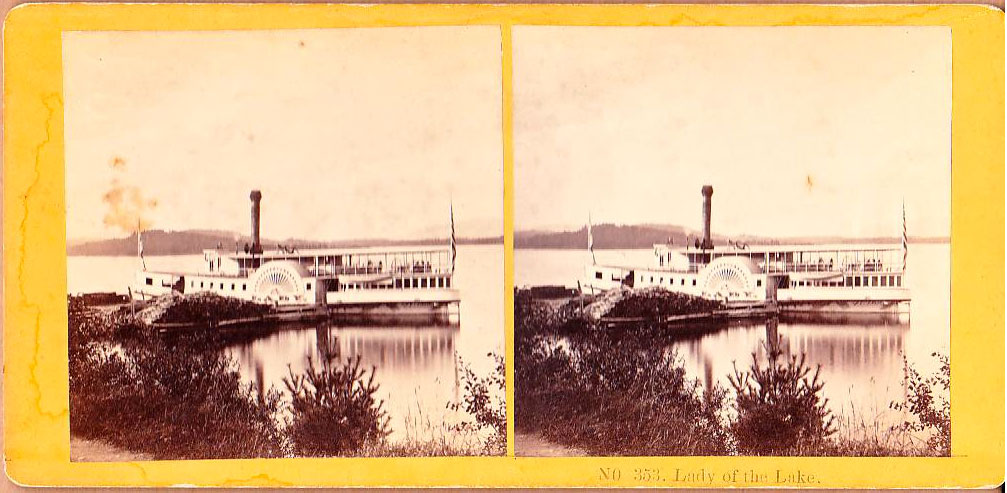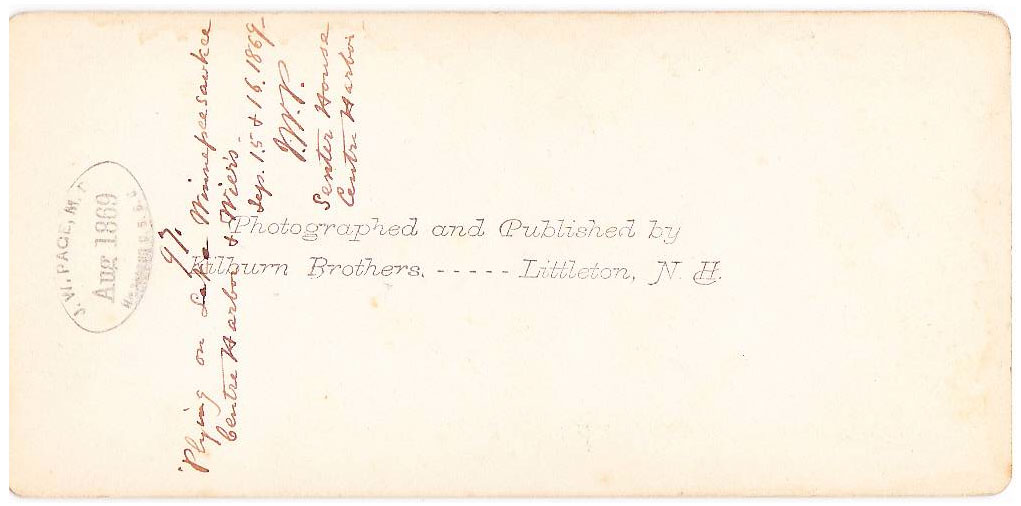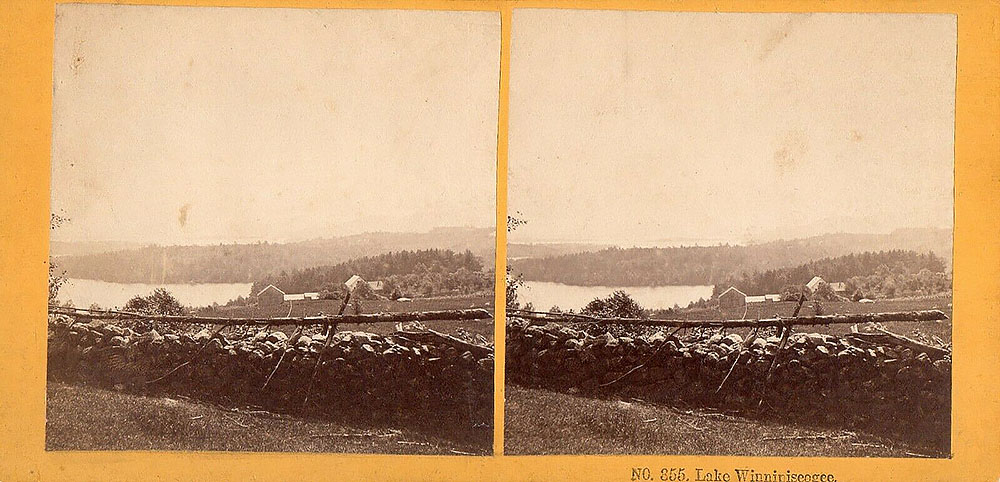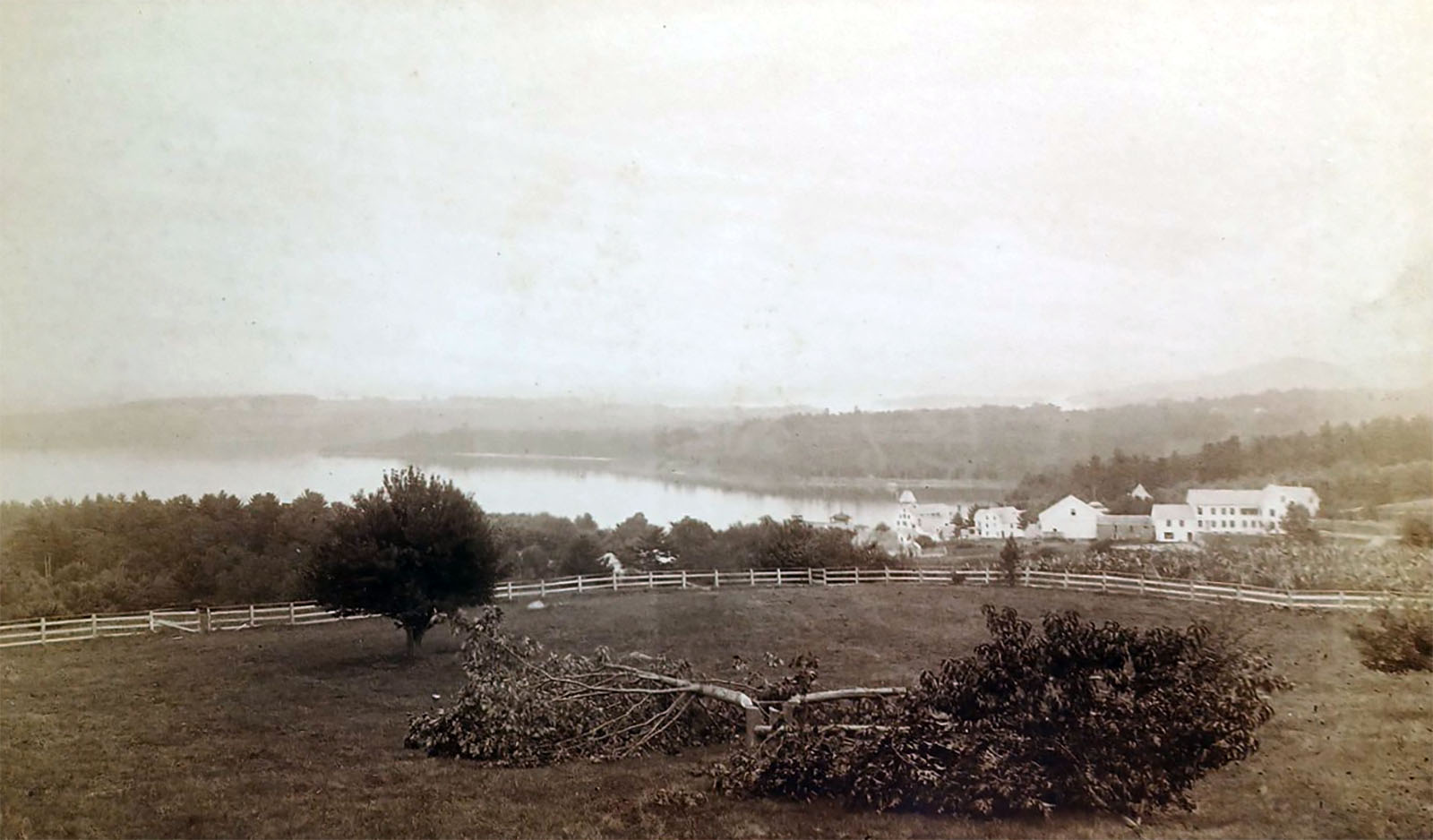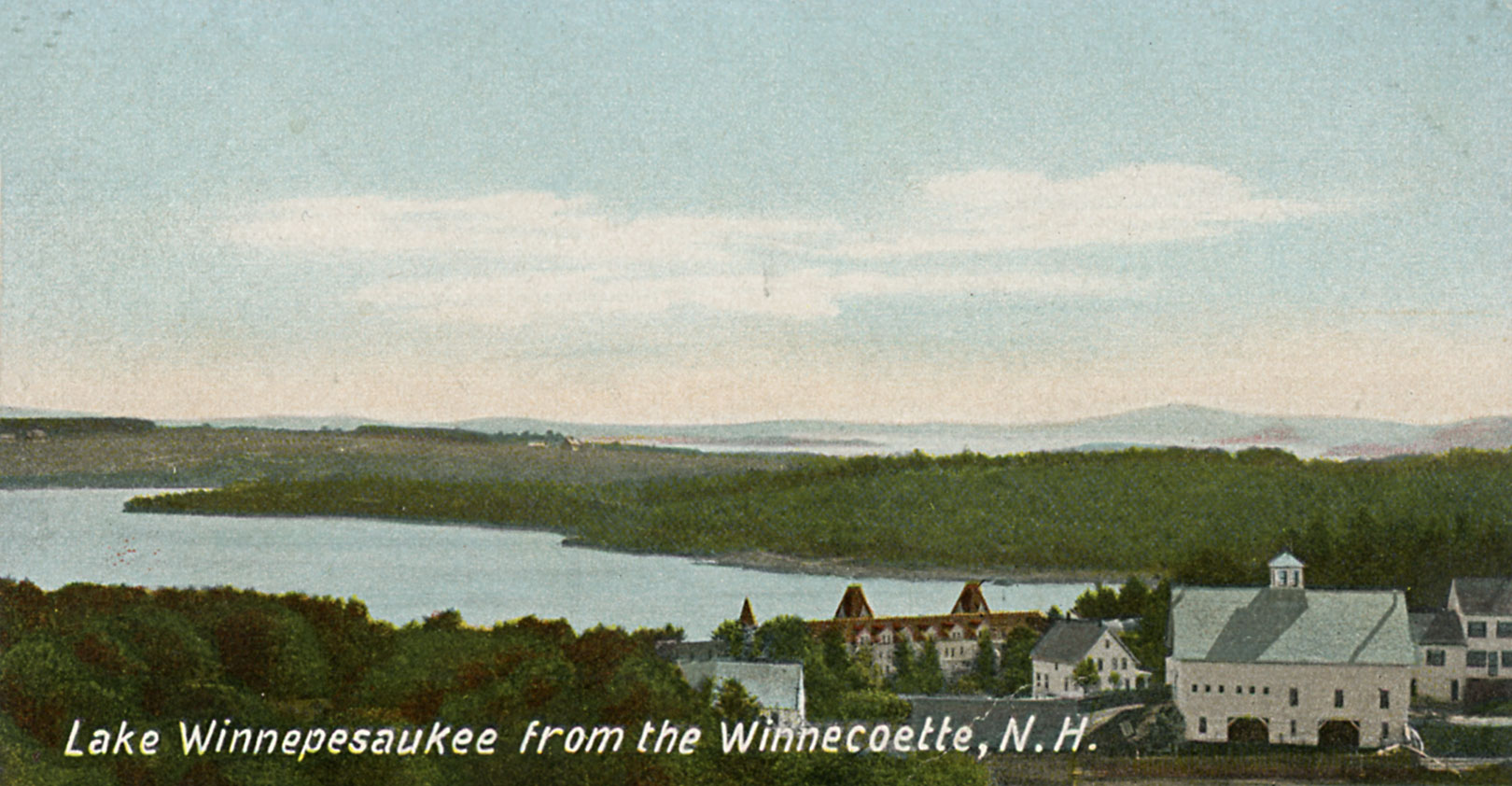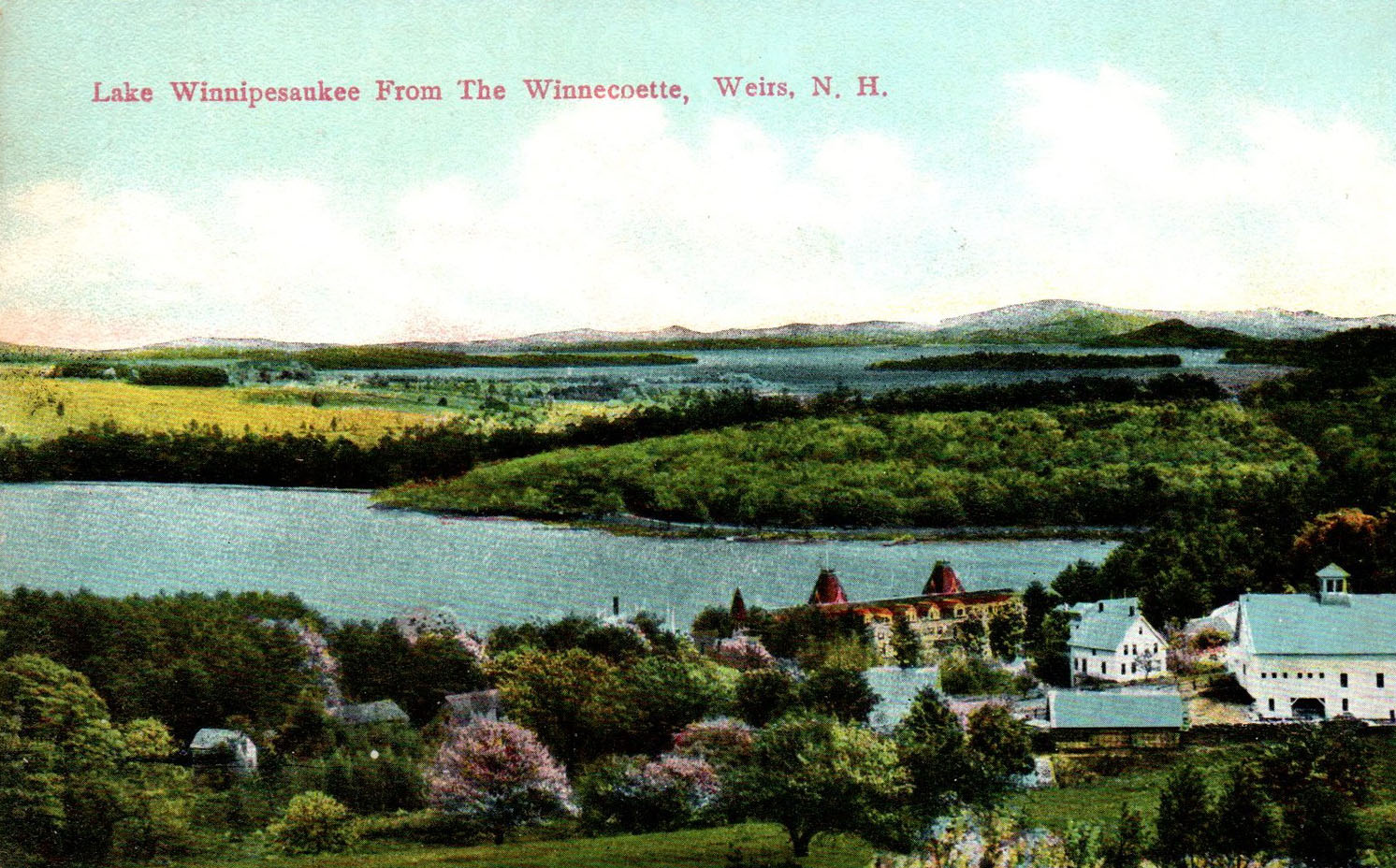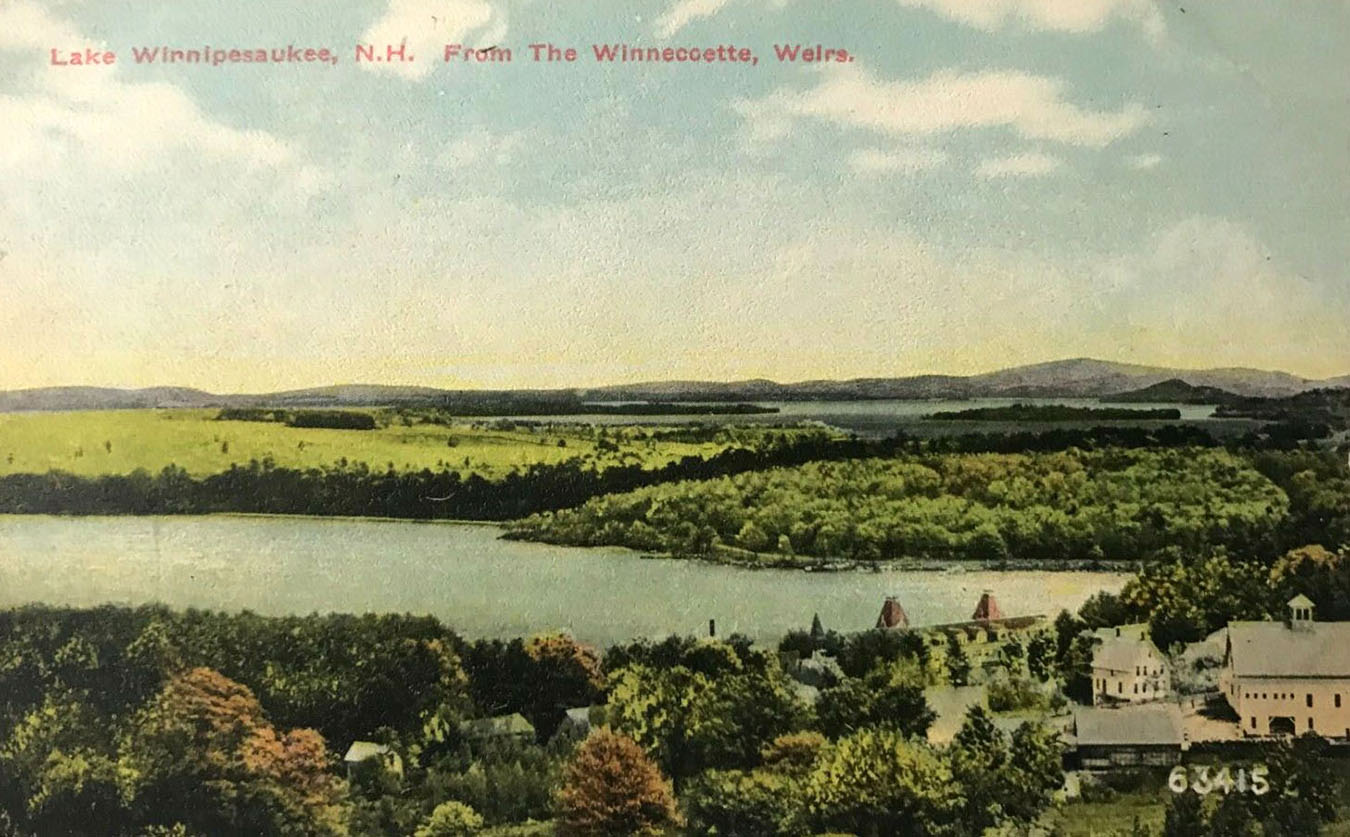Second Weirs Beach Train Station (1880-1892)
The architect of the second, 1880-1892 train station was Arthur L. Davis, who also designed the Hotel Weirs. When Davis passed away on April 18, 1922 at the age of 91, he was considered one of the best known architects and builders in the city.
Here is a stereoview of Weirs Beach from the Kilburn Brothers, No. 761: “Depot and Boat Landing, (Weirs.)” It is a “cabinet size” stereoview of the 2nd railroad station and the Lady of the Lake, early 1880’s, showing the cargo railroad spur that descended under the railroad station. This stereoview is taller than the normal stereoview.
“In the late 1870’s, taller [stereoview] cards and images (often called cabinet size) became popular in the stereoscopic trade. The sales pitch was that they gave the customer a larger image to look at, but in practice the top part of the taller image could only be seen with great difficulty in the standard stereoviewer. This shortcoming soon became apparent to users and the format was abandoned in the late 1880s with a return to the conventional-sized stereoview. In any event, [Benjamin] Kilburn followed the trend for a relatively short period, roughly 1877 to 1883, issuing a substantial group in this format.” – T.K. Treadwell, from “The Photographic Images issued by the Kilburn Company”, published by the Institute for Photographic Research, Monograph Series, #5, Sixth Edition, January, 2002.
Centenary Avenue Wooden Bridge
Below is a view from the rooftop of the second station looking North. Photo taken by F.J. Moulton. The wooden bridge over Centenary Avenue can be clearly seen in the distance, dating the original bridge from the 1880s.
The Centenary Avenue bridge was rebuilt in 1935. According to a January, 1935, Citizen newspaper article, “The Boston and Maine Railroad was placing a new bridge over the tracks just north of Tarlson’s store at the Weirs, supplanting a structure that had been condemned. The new bridge is of the ready-built variety, shipped from one of the railroad’s shops, and an electric crane lifts each section into position. The old bridge has been taken down, necessitating a detour via the ice houses to enter the so-called camp meeting section of the Weirs by automobile. The new bridge is eight feet wider and two feet lower than the old structure.”
A new deck was installed in 2016. It is the only historic wooden bridge remaining in Laconia. It is considered in “Serious” condition and is rated a “3” on a 9-point scale. The bridge is currently slated for a complete replacement by the NH DOT.
The bridge is made of timber beams and trestles set on concrete and stone footings and with mortared cut stone abutments. There are actually 7 spans between the various trestles. The bridge’s weight-carrying capacity is only 7 tons. Current standards are 15 tons for a rehab, and 40 tons for new construction.
The bridge crossing is 120′ long overall. The Lakeside Avenue side of the bridge is 30′ long with an 8% slope. The Weeks Street side of the bridge is 40′ long with a 14% slope. The latter side is considered quite steep, but it is necessary in order to provide 18′ of height over the railroad tracks. Current standards require even more, 22 1/2 feet.
The bridge carries traffic in both directions and features a sidewalk on one side. For this purpose it is quite narrow, only 22.6′ wide. Current minimum standards are 12′ per traffic lane, plus 5′ for a sidewalk, for a total of 30′ of required width.
To replace the bridge with one meeting all of the current standards will be near impossible. It will be interesting to see what type of compromise the ultimate design will be.
Engravings of the Second Train Station
Here’s an engraving of the second train station, captioned “Weirs Station B. and L. R.R. and Lake Winnepesaukee”. This engraving appeared in a 12-page, accordion-folding picture book entitled “Picturesque New Hampshire”, published by Chisholm Bros in the early 1880s. At this time, the Boston & Lowell Railroad serviced the Weirs station. In the engraving, we can see the boardwalk, the station, and the Lady of the Lake steamship. Out in Weirs Bay, the original Mount Washington steamship is also shown – but it seems enormous, way out of scale. Very curiously, on the left shore one can see what looks like another steamer under construction, with a round paddlewheel box clearly visible. This dates the engraving to 1882, when the hull of the Lady was almost entirely rebuilt at the Weirs.
This engraving appeared again, years later, in an undated view book, “Chisholm Bros., Portland, Me. Sole Agents for Chas. Frey’s Original Souvenir Albums”, and was retitled “Weirs Station C&M R.R. Lake Winnipesaukee”. The second version of the engraving featured ornate floral decorations to each side of the engraving.
Views of the Second Train Station from the Lake
Kilburn Stereoviews
A cabinet version of Kilburn stereoview #353, “Lady of the Lake”, shows the Lady of the Lake docked at Weirs Beach. A large woodpile is visible in the foreground, while Stonedam Island can be seen off in the distance. (The card was later reissued with a different picture and title as 353. “Lady of the Lake”, Lake Winnipeseogee. See #6 in the Lady of the Lake Image Collection on this website for the reissued picture.)
Kilburn stereoview #355, “Lake Winnipiseogee”, probably taken at the same time as #351 and #353 above, shows a stone wall, a field, and a sliver of the Lake. The photo was taken from the farm that 10 years later became the grounds of the Winnecoette hotel, and a hundred years later, the Village at Winnipesaukee condiminium development. It shows, just beyond the farm houses, a tree-covered hill steeply sloping into Weirs Bay. This was Tower Hill in 1869, just prior to when real development of Weirs Beach began.
Views From the Winnecoette
Here are four postcards with a similar view to the above. Note the rare view of the New Hotel Weirs from the rear. Nearly all other views of the Hotel show its front side. Also note Governors Island in the background of the postcards. Currently the island’s interior is heavily forested, with almost all the expansive private homes built along the waterfront. At the time of these postcards, nearly the entire island was field and farm.










